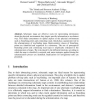Free Online Productivity Tools
i2Speak
i2Symbol
i2OCR
iTex2Img
iWeb2Print
iWeb2Shot
i2Type
iPdf2Split
iPdf2Merge
i2Bopomofo
i2Arabic
i2Style
i2Image
i2PDF
iLatex2Rtf
Sci2ools
SPATIALCOGNITION
2000
Springer
2000
Springer
Schematic Maps as Wayfinding Aids
Schematic maps are effective tools for representing information e physical environment; they depict specific information in an abstract way. This study concentrates on spatial aspects of the physical environment such as branching points and connecting roads, which play a paramount role in the schematization of wayfinding maps. Representative classes of branchingpoints are identified and organized in a taxonomy. The use of prototypical branching points and connecting road types is empirically evaluated in the schematization of maps. The role played by the different functions according to which the map is classified is assessed, and main strategies applied during the schematization process are identified. Implications for navigational tasks are presented.
Branching Points | Information Management | Physical Environment | Prototypical Branching Points | SPATIALCOGNITION 2000 |
| Added | 25 Aug 2010 |
| Updated | 25 Aug 2010 |
| Type | Conference |
| Year | 2000 |
| Where | SPATIALCOGNITION |
| Authors | Hernan Casakin, Thomas Barkowsky, Alexander Klippel, Christian Freksa |
Comments (0)

